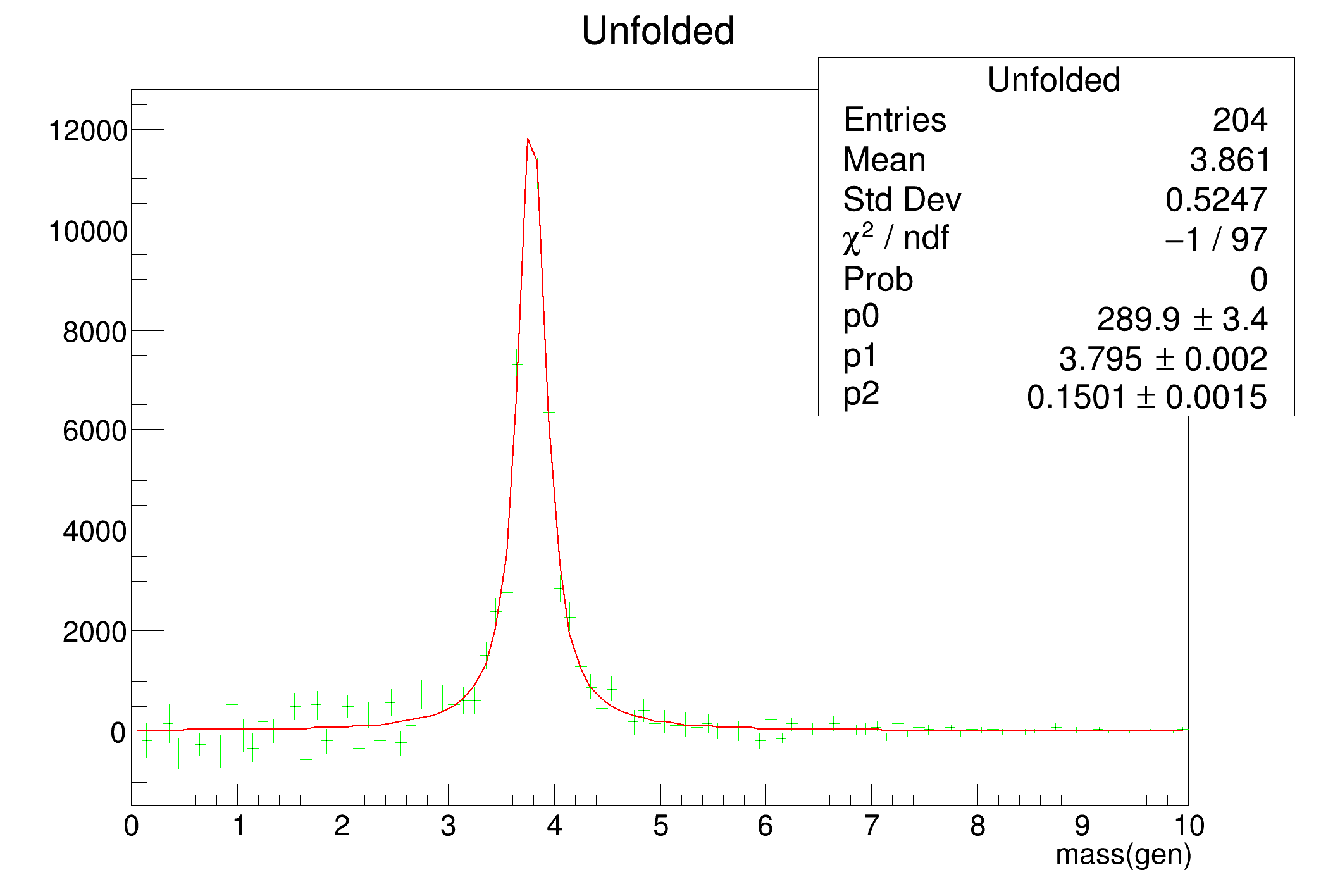using namespace std;
for (
Int_t i=0;i<nPoints;i++) {
else npfit++;
}
for (
Int_t i=0;i<nPoints;i++) {
for (
Int_t j=0;j<nPoints;j++) {
}
}
delete[] df;
}
return par[0]/(dm*dm+par[2]*par[2]);
}
{
do {
do {
} while(t>=1.0);
} while(t<=0.0);
return t;
} else {
do {
do {
} while(t>=1.0);
} while(t>=0.0);
return t;
}
}
return rnd->
Gaus(mTrue+smallBias,smallSigma);
} else {
return rnd->
Gaus(mTrue+wideBias,wideSigma);
}
}
int testUnfold1()
{
TH1D *histMgenMC=
new TH1D(
"MgenMC",
";mass(gen)",nGen,xminGen,xmaxGen);
TH1D *histMdetMC=
new TH1D(
"MdetMC",
";mass(det)",nDet,xminDet,xmaxDet);
TH2D *histMdetGenMC=
new TH2D(
"MdetgenMC",
";mass(det);mass(gen)",
nDet,xminDet,xmaxDet,nGen,xminGen,xmaxGen);
for(
Int_t i=0;i<neventMC;i++) {
4.0,
0.2);
histMgenMC->
Fill(mGen,luminosityData/luminosityMC);
histMdetMC->
Fill(mDet,luminosityData/luminosityMC);
histMdetGenMC->
Fill(mDet,mGen,luminosityData/luminosityMC);
}
TH2D *histMdetGenSysMC=
new TH2D(
"MdetgenSysMC",
";mass(det);mass(gen)",
nDet,xminDet,xmaxDet,nGen,xminGen,xmaxGen);
neventMC=rnd->
Poisson(luminosityMC*crossSection);
for(
Int_t i=0;i<neventMC;i++) {
(0.5,
3.6,
0.15);
histMdetGenSysMC->
Fill(mDet,mGen,luminosityData/luminosityMC);
}
TH1D *histMgenData=
new TH1D(
"MgenData",
";mass(gen)",nGen,xminGen,xmaxGen);
TH1D *histMdetData=
new TH1D(
"MdetData",
";mass(det)",nDet,xminDet,xmaxDet);
for(
Int_t i=0;i<neventData;i++) {
3.8,
0.15);
histMgenData->
Fill(mGen);
histMdetData->
Fill(mDet);
}
TH1D *histDensityGenData=
new TH1D(
"DensityGenData",
";mass(gen)",
nGen,xminGen,xmaxGen);
TH1D *histDensityGenMC=
new TH1D(
"DensityGenMC",
";mass(gen)",
nGen,xminGen,xmaxGen);
for(
Int_t i=1;i<=nGen;i++) {
}
if(unfold.SetInput(histMdetData)>=10000) {
std::cout<<"Unfolding result may be wrong\n";
}
#ifdef VERBOSE_LCURVE_SCAN
#endif
iBest=unfold.ScanLcurve(nScan,tauMin,tauMax,&lCurve,&logTauX,&logTauY);
#ifdef VERBOSE_LCURVE_SCAN
#endif
TH2D *histMdetGenSys1=
new TH2D(
"Mdetgensys1",
";mass(det);mass(gen)",
nDet,xminDet,xmaxDet,nGen,xminGen,xmaxGen);
for(
Int_t i=0;i<=nDet+1;i++) {
for(
Int_t j=0;j<=nGen+1;j++) {
}
}
}
std::cout<<"tau="<<unfold.GetTau()<<"\n";
std::cout<<"chi**2="<<unfold.GetChi2A()<<"+"<<unfold.GetChi2L()
<<" / "<<unfold.GetNdf()<<"\n";
std::cout<<"chi**2(sys)="<<unfold.GetChi2Sys()<<"\n";
TH1 *histMunfold=unfold.GetOutput(
"Unfolded");
TH1 *histMdetFold=unfold.GetFoldedOutput(
"FoldedBack");
TH2 *histEmatTotal=unfold.GetEmatrixTotal(
"EmatTotal");
new TH1D(
"TotalError",
";mass(gen)",nGen,xminGen,xmaxGen);
for(
Int_t bin=1;bin<=nGen;bin++) {
}
TH1 *histRhoi=unfold.GetRhoItotal(
"rho_I",
0,
0,
"*[UO]",
&gHistInvEMatrix
);
gFitter->
SetFCN(chisquare_corr);
TF1 *bw=
new TF1(
"bw",bw_func,xminGen,xmaxGen,3);
histMunfold->
Fit(bw,
"UE");
histMdetGenMC->
Draw(
"BOX");
histTotalError->
Draw(
"E");
histMunfold->
Draw(
"SAME E1");
histDensityGenData->
Draw(
"SAME");
histDensityGenMC->
Draw(
"SAME HIST");
histMdetMC->
Draw(
"SAME HIST");
TH1 *histInput=unfold.GetInput(
"Minput",
";mass(det)");
bestLogTauLogChi2->
Draw(
"*");
output.SaveAs(
"testUnfold1.ps");
return 0;
}
R__EXTERN Int_t gErrorIgnoreLevel
R__EXTERN TStyle * gStyle
virtual void SetLineColor(Color_t lcolor)
Set the line color.
virtual void SetMarkerColor(Color_t mcolor=1)
Set the marker color.
static void RejectPoint(Bool_t reject=kTRUE)
Static function to set the global flag to reject points the fgRejectPoint global flag is tested by al...
virtual Int_t GetNpar() const
virtual void SetNumberFitPoints(Int_t npfits)
virtual Double_t EvalPar(const Double_t *x, const Double_t *params=0)
Evaluate function with given coordinates and parameters.
virtual void InitArgs(const Double_t *x, const Double_t *params)
Initialize parameters addresses.
static Bool_t RejectedPoint()
See TF1::RejectPoint above.
virtual void SetParameter(Int_t param, Double_t value)
A Graph is a graphics object made of two arrays X and Y with npoints each.
virtual void Draw(Option_t *chopt="")
Draw this graph with its current attributes.
1-D histogram with a double per channel (see TH1 documentation)}
virtual Double_t GetBinCenter(Int_t bin) const
Return bin center for 1D histogram.
virtual TFitResultPtr Fit(const char *formula, Option_t *option="", Option_t *goption="", Double_t xmin=0, Double_t xmax=0)
Fit histogram with function fname.
virtual Int_t GetNbinsX() const
virtual void SetBinError(Int_t bin, Double_t error)
Set the bin Error Note that this resets the bin eror option to be of Normal Type and for the non-empt...
virtual Int_t Fill(Double_t x)
Increment bin with abscissa X by 1.
static void SetDefaultSumw2(Bool_t sumw2=kTRUE)
When this static function is called with sumw2=kTRUE, all new histograms will automatically activate ...
virtual void SetBinContent(Int_t bin, Double_t content)
Set bin content see convention for numbering bins in TH1::GetBin In case the bin number is greater th...
virtual void Draw(Option_t *option="")
Draw this histogram with options.
virtual Double_t GetBinContent(Int_t bin) const
Return content of bin number bin.
virtual Double_t GetBinWidth(Int_t bin) const
Return bin width for 1D histogram.
2-D histogram with a double per channel (see TH1 documentation)}
Service class for 2-Dim histogram classes.
Int_t Fill(Double_t)
Invalid Fill method.
virtual Double_t GetBinContent(Int_t bin) const
Return content of bin number bin.
virtual void SetBinContent(Int_t bin, Double_t content)
Set bin content.
Random number generator class based on M.
This is the base class for the ROOT Random number generators.
virtual Double_t Gaus(Double_t mean=0, Double_t sigma=1)
Samples a random number from the standard Normal (Gaussian) Distribution with the given mean and sigm...
virtual Int_t Poisson(Double_t mean)
Generates a random integer N according to a Poisson law.
virtual Double_t Rndm()
Machine independent random number generator.
Base class for spline implementation containing the Draw/Paint methods.
virtual void Draw(Option_t *option="")
Draw this function with its current attributes.
virtual void GetKnot(Int_t i, Double_t &x, Double_t &y) const =0
void SetOptFit(Int_t fit=1)
The type of information about fit parameters printed in the histogram statistics box can be selected ...
An algorithm to unfold distributions from detector to truth level.
@ kSysErrModeRelative
matrix gives the relative shifts
@ kSysErrModeMatrix
matrix is an alternative to the default matrix, the errors are the difference to the original matrix
@ kHistMapOutputVert
truth level on y-axis of the response matrix
Abstract Base Class for Fitting.
virtual TObject * GetObjectFit() const
virtual void SetFCN(void(*fcn)(Int_t &, Double_t *, Double_t &f, Double_t *, Int_t))
To set the address of the minimization objective function called by the native compiler (see function...
virtual TObject * GetUserFunc() const
static TVirtualFitter * Fitter(TObject *obj, Int_t maxpar=25)
Static function returning a pointer to the current fitter.
Double_t Sqrt(Double_t x)
LongDouble_t Power(LongDouble_t x, LongDouble_t y)
static void output(int code)

 Test program for the classes TUnfold and related.
Test program for the classes TUnfold and related. 